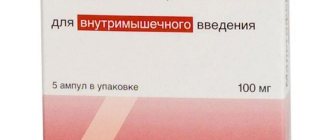Methodject
Hypersensitivity to methotrexate or other components of the drug, severe liver dysfunction, alcoholism, severe renal failure, history of hematopoietic disorders (bone marrow hypoplasia, leukopenia, thrombocytopenia, severe anemia), severe acute or chronic diseases (tuberculosis, HIV infection), ulcers oral cavity, gastrointestinal ulcer in the active phase, pregnancy and lactation, simultaneous vaccination with live vaccines, severe immunodeficiency.
The drug should be used with caution in patients with ascites, dehydration, obstructive gastrointestinal diseases, pleural or peritoneal effusion, and chronic renal failure; for parasitic and infectious diseases of a viral, fungal or bacterial nature (currently or recently suffered, including recent contact with a patient) - herpes simplex, herpes zoster in the viremic phase, chicken pox, measles, amoebiasis, strongyloidiasis established or suspected (risk of developing severe generalized disease); with gout (including a history) or urate nephrolithiasis (including a history), infection and inflammation of the oral mucosa, vomiting and diarrhea (fluid loss due to severe vomiting and diarrhea can lead to increased toxicity of methotrexate), peptic ulcer stomach and duodenum, ulcerative colitis, with previous chemotherapy or radiation therapy, asthenia, in elderly patients.
Side effects:
From the hematopoietic organs: leukopenia and thrombocytopenia, pancytopenia, anemia (including aplastic), neutropenia, agranulocytosis, eosinophilia, lymphadenopathy, lymphoproliferative diseases, hypogammaglobulinemia.
From the digestive system: anorexia, nausea, vomiting, stomatitis, gingivitis, pharyngitis, enteritis, erosive and ulcerative lesions and bleeding from the gastrointestinal tract (including melena, hematemesis), hepatotoxicity (acute hepatitis, fibrosis and cirrhosis of the liver, liver failure, hypoalbuminemia , increased activity of “liver” transaminases), pancreatitis.
From the nervous system: headache, drowsiness, dysarthria, aphasia, hemiparesis, paresis, convulsions; when used in high doses - transient impairment of cognitive functions, emotional lability; unusual cranial sensitivity, encephalopathy (including leukoencephalopathy).
From the skin: erythematous rash, skin itching, urticaria, photosensitivity, skin pigmentation disorders, alopecia, ecchymosis, telangiectasia, acne, furunculosis, erythema multiforme (including Stevens-Johnson syndrome), toxic epidermal necrolysis, ulceration and necrosis of the skin, exfoliative dermatitis.
From the senses: conjunctivitis, visual impairment (including transient blindness).
From the respiratory system: pulmonary fibrosis, respiratory failure, alveolitis, interstitial pneumonitis (including fatal), COPD.
From the cardiovascular system: pericarditis, pericardial effusion, decreased blood pressure, thromboembolism (including arterial thrombosis, thrombosis of cerebral vessels, deep vein thrombosis, retinal vein thrombosis, thrombophlebitis, pulmonary embolism).
From the genitourinary system: nephropathy (including severe) or renal failure, azotemia, cystitis, hematuria, proteinuria, impaired spermato- and oogenesis, transient oligospermia, decreased libido, impotence, dysmenorrhea, vaginal discharge, gynecomastia, infertility, spontaneous abortion, fetal death, fetal development abnormalities.
From the musculoskeletal system: arthralgia, myalgia, osteoporosis, osteonecrosis, fractures.
Infections: life-threatening opportunistic infections (including Pneumocystis pneumonia), CMV (including CMV pneumonia), sepsis (including fatal), nocardiosis, histoplasmosis, cryptococcosis, infections caused by Herpes zoster and Herpes simplex (including disseminated).
Other: vasculitis, diabetes mellitus, lymphoma (including reversible), tumor lysis syndrome, soft tissue necrosis, anaphylactoid reactions, sudden death.
In case of an overdose of the drug, the toxic effect of methotrexate is mainly manifested from the hematopoietic system. For treatment, the introduction of a specific antidote - folinic acid preparations (immediately if possible) is indicated to neutralize the toxic effect of methotrexate. In case of accidental overdose, within the first hour after administration of methotrexate, a specific antidote - folinic acid - should be administered intravenously or intramuscularly in a dose equal to or higher than the dose of methotrexate. Further, as necessary, the administration of folinic acid preparations should be continued until the concentration of methotrexate in the blood serum is below 10-7 mol/l.
In case of significant overdose, to prevent precipitation of methotrexate and/or its metabolites in the renal tubules, the body is hydrated and the urine is alkalinized, which accelerates the excretion of methotrexate. Hemodialysis and peritoneal dialysis do not accelerate the elimination of methotrexate. The effectiveness of intermittent (periodic) hemodialysis using a high-speed dialysis machine has been reported.
Pharmacodynamics and pharmacokinetics
Cytostatic antitumor drug of the antimetabolite , converts dihydrofolic acid into tetrahydrofolic acid. Inhibits DNA and cell mitosis . of malignant tumors , embryonic and epithelial cells of the intestinal mucosa, bladder, and oral cavity are especially sensitive to its action Also has an immunosuppressive effect.
Approximately half of the administered dose of methotrexate is bound to plasma proteins. The time of formation of the highest concentration is 0.5-1 hour. Food slows down the absorption of the drug. The terminal half-life is about 6-7 hours and, depending on the patient's condition and dose, can vary greatly (3-17 hours). The half-life increases up to 4 times in patients with ascites and pleural effusion.
About 10% of the volume is metabolized in the liver. Excretion occurs in most cases unchanged, mainly through the kidneys. About 6-21% of methotrexate and 2-4% of 7-hydroxymethotrexate are excreted in the bile . Enterohepatic circulation is observed in a pronounced form.
In renal failure, the elimination of methotrexate from the body is significantly delayed, and there is no information about the reasons for the delay.
Metoject solution for 10 mg/ml syringe 1 ml with needle 86450
Description
Metoject® Medac (Germany) injection solution 10 mg/ml; glass syringe 1 ml with needle(s), blister 1, cardboard pack 1; EAN code: 4037353005044; No. LSR-006731/09, 2009-08-21 from Medac (Germany); manufacturer: Oncotec Pharma Produktion GmbH (Germany) Latin name Metoject Active ingredient Methotrexate * (Methotrexatum) ATX: L01BA01 Methotrexate Pharmacological group Antitumor agent - antimetabolite [Immunosuppressants] Nosological classification (ICD-10) L40 Psoriasis M06.9 Rheumatoid arthritis, unspecified M0 7.3 Other psoriatics arthropathy (L40.5+) M08 Juvenile arthritis M13.0 Polyarthritis, unspecified Pharmacological action Pharmacological action - immunosuppressive, antitumor. Release form Solution for injection, 10 mg/ml. 7.5 mg/0.75 ml, 10 mg/1 ml, 15 mg/1.5 ml, 20 mg/2 ml or 25 mg/2.5 ml in a graduated syringe made of neutral colorless glass (type 1 E. F.), closed with a rubber stopper, with a polymer attachment on the flange, in a PVC/paper blister. Injection needle in PE/paper blister. 1 filled syringe with the drug and 1 needle in a blister are placed in a cardboard box. Manufacturer medak GmbH. Theaterstrasse 6, 22880 Wedel, Germany. Manufacturer of the finished dosage form: Oncotech Pharma Production GmbH, Am Pharmapark, 96861 Dessau-Rosslau, Germany. Manufacturer performing secondary packaging and quality control: medak GmbH. Felandstrasse 3, 20354 Hamburg, Germany/ Theaterstrasse 6, 22880 Wedel, Germany. Claims from consumers and complaints about the quality of the drug should be sent to the representative's address. 121087, Moscow, st. Barclay, 6, bldg. 5, of. 417. Tel./fax. Conditions for dispensing from pharmacies By prescription. Storage conditions for the drug Metojekt®: In a dry place, protected from light, at a temperature not exceeding 25 °C. Do not freeze. Keep out of reach of children. The shelf life of the drug Metoject® is 2 years. Do not use after the expiration date stated on the package. 2000-2015. Register of Medicines of Russia The database is intended for healthcare professionals. Commercial use of materials is not permitted.
Possible product names
- Metoject solution d/i 10 mg/ml syringe 1 ml with needle
- METODJECT 10 MG/ML RR D/IN. 1.0 ML SYRINGE No. 1
- METODJECT 10 MG/ML 10 MG N1 SYRINGE RR D/IN
- METOJECT R-R D/IN. 10 MG/ML 1ML SYRINGE No. 1 SET. WITH NEEDLE. INJECTION
- METODJECT 10MG/ML RR D/IN. 1ML - ShPR. WITH NEEDLE. X1 B M (R)
- (Metoject) Metoject solution d/i 10 mg/ml syringe 1 ml with needle
Interaction
When taking alcohol and drugs that are toxic to the liver and hematopoietic system, the risk of developing structural and functional disorders of the liver and hematopoietic organs increases.
The use of antibiotics in some cases reduces the elimination of methotrexate, which leads to an increase in its amount in plasma, threatening the occurrence of hematological toxicity . An increase in the drug elimination time can also occur when using omeprazole , pantoprazole as proton pump inhibitors.
When prescribing drugs that can cause a decrease in the amount of folate in the body, it should also be taken into account that these substances, for example sulfonamides , increase the deficiency of folic acid in the body and increase the toxic effect of methotrexate.
Taking folate-containing medications that reduce the amount of methotrexate toxins that affect the bone marrow (multivitamins, etc.) has a beneficial effect.
Features of use during pregnancy
Taking Metoject is strictly prohibited for pregnant and lactating women. Methotrexate has a toxic effect on the fetus, causing softening of the bones of the limbs and head. Before planning a pregnancy, it is recommended to stop taking the drug and consult with a geneticist to determine possible risks, since methotrexate has a toxic effect on the patient’s genome. Women taking Metoject and those planning a pregnancy are advised to stop taking the drug at least six months before the expected conception. If a woman becomes pregnant during therapy, the risk of side effects of the drug on fetal development is assessed.
Similar drugs:
- Diprospan Solution for injection
- Prednisolone Oral tablets
- Imuran Oral tablets
- Prednisolone Solution for injection
- Diprospan Suspension for injection
- Restasis Eye Drops
- Leflunomide Oral tablets
- Cyclosporin Capsule
- Decadron (Decadron) Solution for injection
- Azathioprine Tablets
** The Drug Directory is intended for informational purposes only. For more complete information, please refer to the manufacturer's instructions. Do not self-medicate; Before starting to use Metoject, you should consult a doctor. EUROLAB is not responsible for the consequences caused by the use of information posted on the portal. Any information on the site does not replace medical advice and cannot serve as a guarantee of the positive effect of the drug.
Are you interested in the drug Metoject? Do you want to know more detailed information or do you need a doctor's examination? Or do you need an inspection? You can make an appointment with a doctor - the Euro lab is always at your service! The best doctors will examine you, advise you, provide the necessary assistance and make a diagnosis. You can also call a doctor at home . Euro lab clinic is open for you around the clock.
** Attention! The information presented in this medication guide is intended for medical professionals and should not be used as a basis for self-medication. The description of the drug Metojekt is provided for informational purposes only and is not intended for prescribing treatment without the participation of a doctor. Patients need to consult a specialist!
If you are interested in any other drugs and medications, their descriptions and instructions for use, information about the composition and form of release, indications for use and side effects, methods of use, prices and reviews of drugs, or you have any other questions and suggestions - write to us, we will definitely try to help you.






